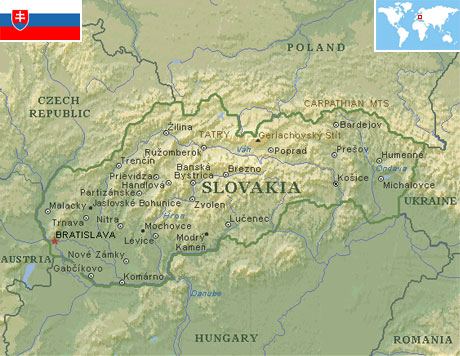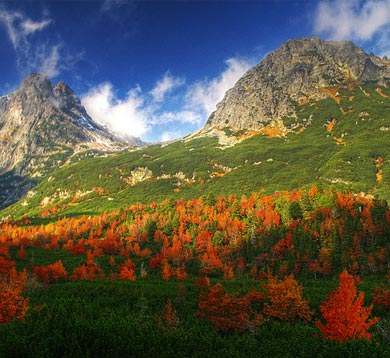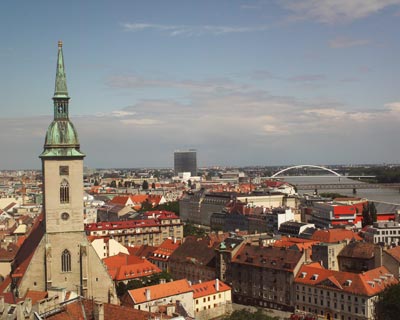Slovakia
Country statistics

Land area: 18,842 sq miles (48,800 sq km)
Total area: 18,859 sq miles (48,845 sq km)
Population (2010 est.): 5,470,306 (growth rate: 0.1%); birth rate: 10.5/1000; infant mortality rate: 6.7/1000; life expectancy: 75.6; density per sq miles: 289
Capital City: Bratislava
Monetary unit: Koruna
Languages: Slovak 84% (official), Hungarian 11%, Roma 2%, Ukrainian 1% (2001)
Ethnicity/race: Slovak 85.8%, Hungarian 9.7%, Roma 1.7%, Ruthenian/Ukrainian 1%, other and unspecified 1.8% (2001)
Religions: Roman Catholic 69%, Protestant 11%, Greek Catholic 4%, none 13% (2001)
Country introduction

Slovakia is a landlocked state in Central Europe, bordered by the Czech Republic and Austria to the west, Poland to the north, Ukraine to the east and Hungary to the south. The largest city is the capital, Bratislava, and the second largest is Košice.
The Slovak landscape is noted primarily for its mountainous nature, with the Carpathian Mountains extending across most of the northern half of the country. Amongst these mountain ranges are the high peaks of the Tatra mountains. To the north, close to the Polish border, are the High Tatras which are a popular skiing destination and home to many scenic lakes and valleys as well as the highest point in Slovakia, the Gerlachovský štít at 2,655 m (8,711 ft), and the country's highly symbolic mountain Kriváň.
Some 40% of Slovakia is covered with forests. Slovakia's forests contain a wide biodiversity and animals include brown bears, wolves, foxes, wild boars, muskrats, chamois and lynxes.
Major Slovak rivers are the Danube, the Váh and the Hron. Rivers and streams in the mountains of Slovakia are often used for rafting and other white-water based activities and sports.
The culture

Slovaks were subject to cultural repression by foreign governments, which is evident in much of the Slovakian literature, art and music. The emergence of a national culture and literature for Slovakia came late. Despite this, the country has a rich literary heritage, a varied tradition in music and a diverse and original folklore.
Slovakian culture is influenced by its rich folk traditions. Each region, city, and municipality has a unique character and folklore, including costumes, music, songs, architecture, customs, traditions, dances and dialects. Folklore festivals organised all around Slovakia serve to present the folk customs of individual regions.
The largest folk festivals in Slovakia are held in the towns of Východná, Myjava, and Detva. Other festivals are more regional in nature, but their quality is usually comparable to that of these three festivals. Generally speaking, there are significant differences among festivals, and each has its own distinctive atmosphere and charm. During the best festivals the whole village, city, or even the whole region follows the festival, and folklore can be felt at every turn.
Slovakia is a predominantly Catholic Country, so major Christian holidays are observed, as well as some other holidays which are heavily influenced on traditions and Slovak history. For example, the carrying of Morena (in the form of a straw effigy dressed in woman's clothing) symbolises the end of winter and the arrival of spring. On January 6th, boys go from door to door dressed up as the three Wise Men, singing carols and performing the Twelfth Night play. Shrovetide is celebrated as a season of entertainment and feast, which culminates with a carnival representing different animals. After Shrovetide, Christians observe Lent, a forty-day period of fasting leading up to Easter. The most important Christian holiday of the year is Easter, which is celebrated differently in individual regions.
Attractions & landmarks

One of Slovakia's main tourist attractions are the Tatra Mountains, (particularly the High Tatras), the highest part of the Carpathians. They feature many rare plant and animal species and offer numerous ski, hiking and mountaineering opportunities.
Slovakia land consists of quite a bit of limestone and water, and together, they have formed a lot of caves great for an explorer's adventure. Slovakia is also a place to observe waterfalls and deep canyons.
The Capital of Slovakia, Bratislava, offers several notable cathedrals and churches to seek out. The architectural structures on the outside of the Franciscan church are truly captivating, and consists of intricately inlaid designs on the inside. Other churches to consider visiting are St. Clare's church, St. Martin's Cathedral, Church of the Holy Savior, and the Blue Church (also known as the Church of St. Elisabeth).
The country is home to the most castles and chateaux in the world making it a gold mine for any history enthusiast. Bratislava's famous landmark belongs to the Bratislava Castle, which was built in the 10th century. It is situated on a plateau 82 m (269 ft) above the Danube. There is one other castle connected to Bratislava worth seeing called the Devin Castle. Considered to be the Gate to Bratislava, it now lies in ruins and is situated on the outskirts, on top of a high rock above the place where the Morava River flows into the Danube.
More than 50 museums exist in the capital and one of the most influential is the The Slovak National Museum (founded in 1893), which contains exhibits on Slovak history, archaeology, and musicology. Other museums include the Slovak National Gallery (1948), also in Bratislava, the Slovak National Uprising Museum (1955), located in Banska Bystrica, and the Museum of Eastern Slovakia (1872), in Kosice.